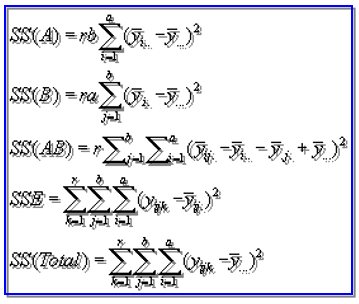Statement of the Problem: Research Questions and Hypotheses
In this exercise, the concept of interest is efficiency or speed of learning. In turn, there are two constructs – having to do with teaching style and type of learning activity – that may explain, predict and eventually control the concept under study. Then, the conceptual and operational definition for this exercise is that teaching style and type of learning activity jointly influence the degree of knowledge gained. Accordingly, the research questions and null hypotheses may be articulated as follows:
- RQ1: Do teaching style and type of learning activity interact to influence learning efficacy?
- H01: There is no difference in learning efficacy across all combinations of learning activity and teaching style.
- RQ2: Taken in isolation, what is the effect of teaching style on learning efficacy?
- H02: There is no difference in learning efficacy across five teaching styles.
- RQ3: What effect does type of learning activity have, by itself, on learning efficacy?
- H03: There is no difference in learning efficacy across three types of learning activity.
Research Design: The Variables Operationalized
This is a 5 X 3 experiment since the study instrument that measures learning efficacy was administered across all fifteen combinations of teaching style and learning activity. The given information for this exercise does not define the measurement instrument. The nature of the data suggests, however, that a) the instrument is quantitative; b) the distribution of scores suggests that 100 is the midpoint of the normal curve; and, c) from which fact one may realize that “knowledge gained” is a ratio variable.
Given the preceding discussion around statement of the problem (section I above), it is evident that learning efficacy or knowledge gained is the dependent variable (DV). In turn, performance on the measurement instrument is a function of the two independent variables (IVs) teaching style and learning activity.
The Data-Analysis Procedure: Two-Way Anova
Evaluation of the two-way ANOVA result rests on surpassing the value of α = 0.05. This is a common benchmark in the social sciences (Norusis, 2009) that means, quite simply, that observed differences are unlikely to be due to chance occurrence alone if they are observed less than 5 percent of the time or once in twenty replications of the experiment in question.
Since the sample data has equal numbers of observations across all fifteen cells of the research design, the calculation of sum of squares for the interaction effect: Learning Activity X Teaching style is performed as follows:
SS(total) = SS(A) + SS(B) + SS(AB) + SSE, where A = Learning Activity and B = Teaching Style. The formulas to compute the sums of squares are given alongside.

To construct the summary of between-subjects effects (Table 1 overleaf), we plug in for “Learning Activity” SS(A), degrees of freedom (df) = treatments -1 = 3-1= 2, and Mean Square = MS(A) = SS(A)/(a-1). The corresponding source for “Teaching Style” is derived similarly: SS(B) for the sum of squares, df = treatments -1 = 5-1 = 4, and MS(B) = SS(B)/(b-1). In both cases, a and b stand for the levels of treatments for the two factors. The related cells for the interaction effect of teaching styles and learning activity are given by (from the equations above): SS(AB), df = (a-1)(b-1), and MS(AB)= SS(AB)/(a-1)(b-1) (Norusis, 2009).
The results (Table 1 below) is statistically significant for the main effects but not for the interaction factor. The calculated F values for both learning activity and teaching style bear significance statistics of p <0.001. Since these are far lower than the requirement of α = 0.05, we conclude that the observed differences in knowledge gained by level of either factor cannot be attributed purely to chance. The odds of such differences arising randomly are at least one in 10,000 experimental replications. Hence, we reject both H02 and H03and accept the alternate hypotheses that teaching styles and type of learning activity individually impact the DV, knowledge gained.
Table 1.
On the other hand, the calculated F for the interaction effect is so low (1.97) that p < 0.5. More precisely, the differences owing to hypothesized interaction between the two factors could have occurred by change about once in eight experimental trials or re-samplings. Hence, we accept H01 and conclude that there is no difference in learning efficacy across all combinations of learning activity and teaching style.
Reference
Norušis, M. J. (2009). SPSS 17.0 guide to data analysis. Upper Saddle River, NJ: Prentice Hall.
